Leadership Styles and Organizational Impact in Retail Fashion
VerifiedAdded on 2023/01/03
|24
|8614
|67
Report
AI Summary
This report investigates leadership styles and their impact on organizational performance within the retail fashion industry, focusing on case studies of Superdry and Forever21. The introduction highlights the importance of leadership in navigating global economic instability and technological advancements. The research aims to analyze leadership styles, evaluate the reasons for management failures, and assess the influence of different leadership approaches. The literature review covers the evolution of leadership styles, from traditional transactional approaches to transformational leadership, and their effects on organizational outcomes. The methodology section describes the case study approach. The report examines the impact of leadership styles on communication, employee motivation, and overall organizational success, providing insights into the factors that contribute to both effective and ineffective management. The report concludes with recommendations for improving leadership practices and addressing faulty management within the retail sector.
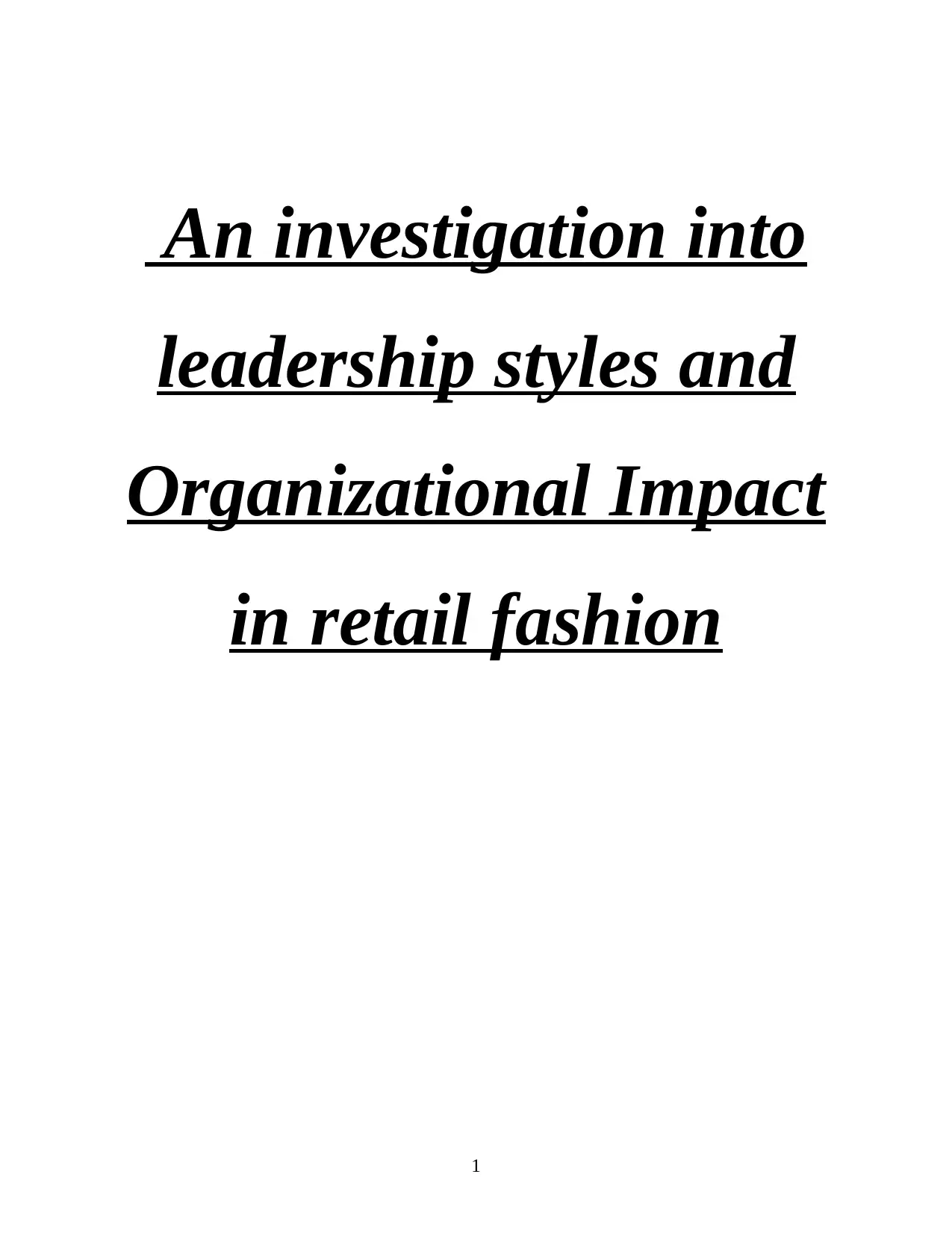
An investigation into
leadership styles and
Organizational Impact
in retail fashion
1
leadership styles and
Organizational Impact
in retail fashion
1
Paraphrase This Document
Need a fresh take? Get an instant paraphrase of this document with our AI Paraphraser
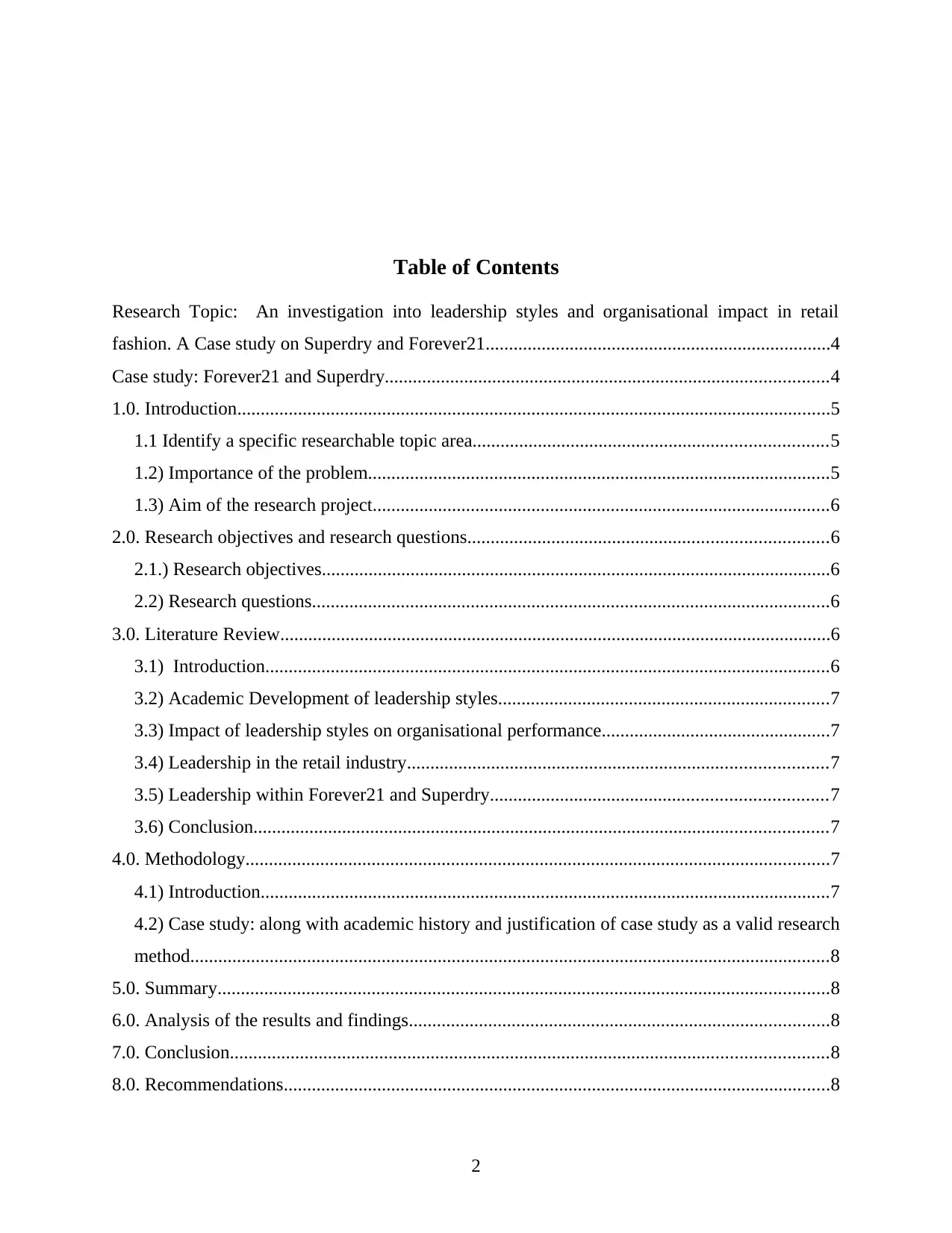
Table of Contents
Research Topic: An investigation into leadership styles and organisational impact in retail
fashion. A Case study on Superdry and Forever21..........................................................................4
Case study: Forever21 and Superdry...............................................................................................4
1.0. Introduction...............................................................................................................................5
1.1 Identify a specific researchable topic area............................................................................5
1.2) Importance of the problem...................................................................................................5
1.3) Aim of the research project..................................................................................................6
2.0. Research objectives and research questions.............................................................................6
2.1.) Research objectives.............................................................................................................6
2.2) Research questions...............................................................................................................6
3.0. Literature Review......................................................................................................................6
3.1) Introduction.........................................................................................................................6
3.2) Academic Development of leadership styles.......................................................................7
3.3) Impact of leadership styles on organisational performance.................................................7
3.4) Leadership in the retail industry..........................................................................................7
3.5) Leadership within Forever21 and Superdry........................................................................7
3.6) Conclusion...........................................................................................................................7
4.0. Methodology.............................................................................................................................7
4.1) Introduction..........................................................................................................................7
4.2) Case study: along with academic history and justification of case study as a valid research
method.........................................................................................................................................8
5.0. Summary...................................................................................................................................8
6.0. Analysis of the results and findings..........................................................................................8
7.0. Conclusion................................................................................................................................8
8.0. Recommendations.....................................................................................................................8
2
Research Topic: An investigation into leadership styles and organisational impact in retail
fashion. A Case study on Superdry and Forever21..........................................................................4
Case study: Forever21 and Superdry...............................................................................................4
1.0. Introduction...............................................................................................................................5
1.1 Identify a specific researchable topic area............................................................................5
1.2) Importance of the problem...................................................................................................5
1.3) Aim of the research project..................................................................................................6
2.0. Research objectives and research questions.............................................................................6
2.1.) Research objectives.............................................................................................................6
2.2) Research questions...............................................................................................................6
3.0. Literature Review......................................................................................................................6
3.1) Introduction.........................................................................................................................6
3.2) Academic Development of leadership styles.......................................................................7
3.3) Impact of leadership styles on organisational performance.................................................7
3.4) Leadership in the retail industry..........................................................................................7
3.5) Leadership within Forever21 and Superdry........................................................................7
3.6) Conclusion...........................................................................................................................7
4.0. Methodology.............................................................................................................................7
4.1) Introduction..........................................................................................................................7
4.2) Case study: along with academic history and justification of case study as a valid research
method.........................................................................................................................................8
5.0. Summary...................................................................................................................................8
6.0. Analysis of the results and findings..........................................................................................8
7.0. Conclusion................................................................................................................................8
8.0. Recommendations.....................................................................................................................8
2

REFERENCES..............................................................................................................................10
3
3
⊘ This is a preview!⊘
Do you want full access?
Subscribe today to unlock all pages.

Trusted by 1+ million students worldwide
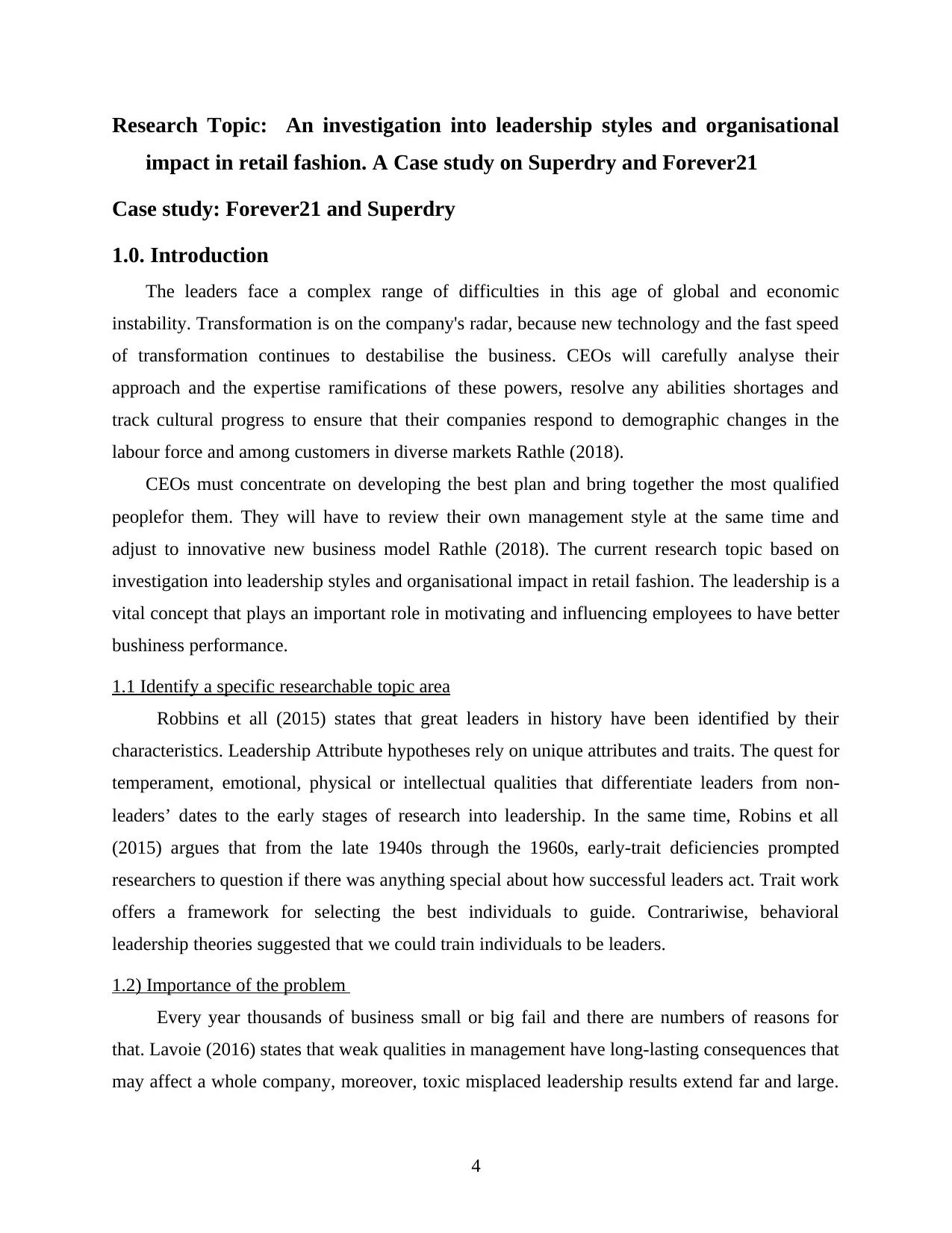
Research Topic: An investigation into leadership styles and organisational
impact in retail fashion. A Case study on Superdry and Forever21
Case study: Forever21 and Superdry
1.0. Introduction
The leaders face a complex range of difficulties in this age of global and economic
instability. Transformation is on the company's radar, because new technology and the fast speed
of transformation continues to destabilise the business. CEOs will carefully analyse their
approach and the expertise ramifications of these powers, resolve any abilities shortages and
track cultural progress to ensure that their companies respond to demographic changes in the
labour force and among customers in diverse markets Rathle (2018).
CEOs must concentrate on developing the best plan and bring together the most qualified
peoplefor them. They will have to review their own management style at the same time and
adjust to innovative new business model Rathle (2018). The current research topic based on
investigation into leadership styles and organisational impact in retail fashion. The leadership is a
vital concept that plays an important role in motivating and influencing employees to have better
bushiness performance.
1.1 Identify a specific researchable topic area
Robbins et all (2015) states that great leaders in history have been identified by their
characteristics. Leadership Attribute hypotheses rely on unique attributes and traits. The quest for
temperament, emotional, physical or intellectual qualities that differentiate leaders from non-
leaders’ dates to the early stages of research into leadership. In the same time, Robins et all
(2015) argues that from the late 1940s through the 1960s, early-trait deficiencies prompted
researchers to question if there was anything special about how successful leaders act. Trait work
offers a framework for selecting the best individuals to guide. Contrariwise, behavioral
leadership theories suggested that we could train individuals to be leaders.
1.2) Importance of the problem
Every year thousands of business small or big fail and there are numbers of reasons for
that. Lavoie (2016) states that weak qualities in management have long-lasting consequences that
may affect a whole company, moreover, toxic misplaced leadership results extend far and large.
4
impact in retail fashion. A Case study on Superdry and Forever21
Case study: Forever21 and Superdry
1.0. Introduction
The leaders face a complex range of difficulties in this age of global and economic
instability. Transformation is on the company's radar, because new technology and the fast speed
of transformation continues to destabilise the business. CEOs will carefully analyse their
approach and the expertise ramifications of these powers, resolve any abilities shortages and
track cultural progress to ensure that their companies respond to demographic changes in the
labour force and among customers in diverse markets Rathle (2018).
CEOs must concentrate on developing the best plan and bring together the most qualified
peoplefor them. They will have to review their own management style at the same time and
adjust to innovative new business model Rathle (2018). The current research topic based on
investigation into leadership styles and organisational impact in retail fashion. The leadership is a
vital concept that plays an important role in motivating and influencing employees to have better
bushiness performance.
1.1 Identify a specific researchable topic area
Robbins et all (2015) states that great leaders in history have been identified by their
characteristics. Leadership Attribute hypotheses rely on unique attributes and traits. The quest for
temperament, emotional, physical or intellectual qualities that differentiate leaders from non-
leaders’ dates to the early stages of research into leadership. In the same time, Robins et all
(2015) argues that from the late 1940s through the 1960s, early-trait deficiencies prompted
researchers to question if there was anything special about how successful leaders act. Trait work
offers a framework for selecting the best individuals to guide. Contrariwise, behavioral
leadership theories suggested that we could train individuals to be leaders.
1.2) Importance of the problem
Every year thousands of business small or big fail and there are numbers of reasons for
that. Lavoie (2016) states that weak qualities in management have long-lasting consequences that
may affect a whole company, moreover, toxic misplaced leadership results extend far and large.
4
Paraphrase This Document
Need a fresh take? Get an instant paraphrase of this document with our AI Paraphraser
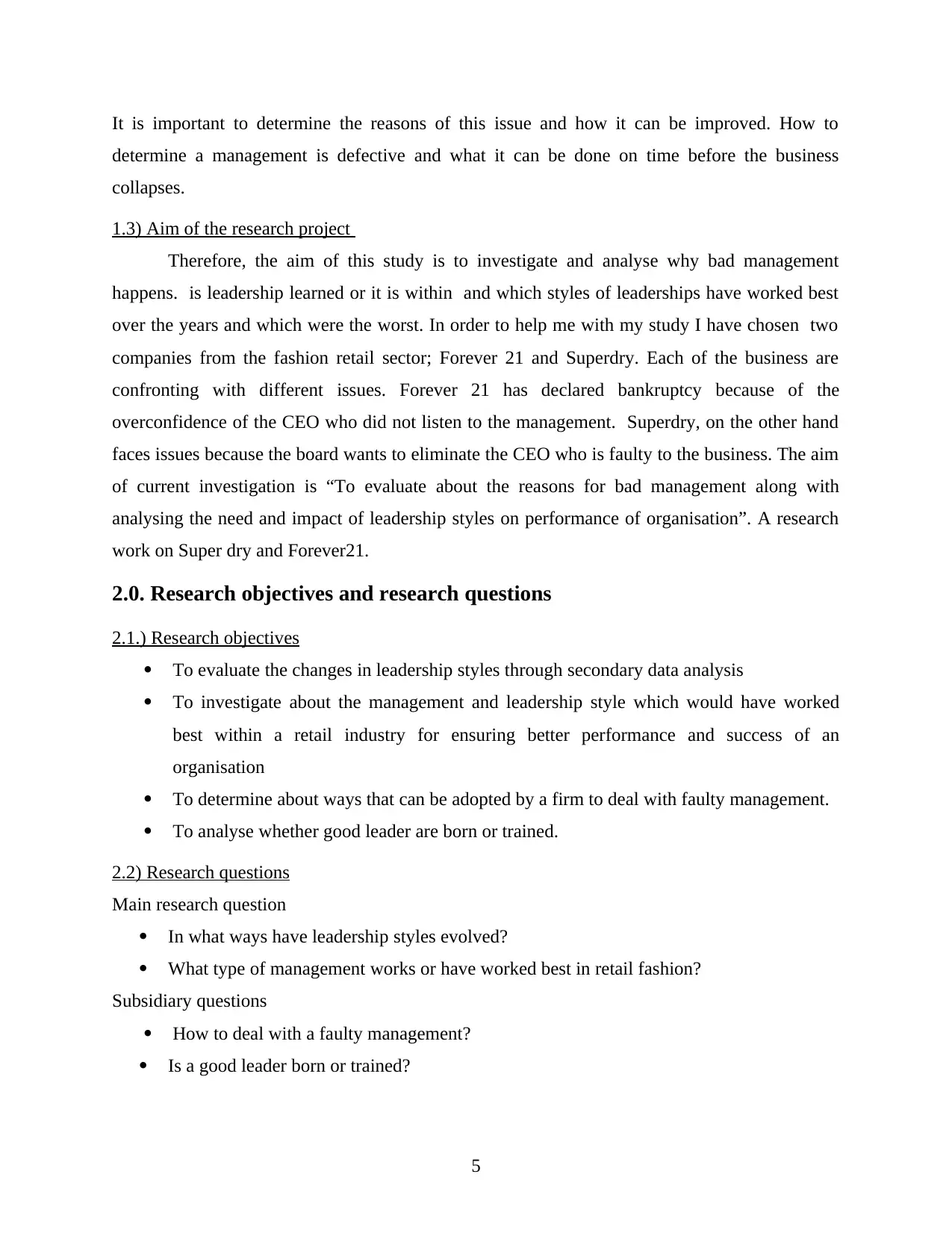
It is important to determine the reasons of this issue and how it can be improved. How to
determine a management is defective and what it can be done on time before the business
collapses.
1.3) Aim of the research project
Therefore, the aim of this study is to investigate and analyse why bad management
happens. is leadership learned or it is within and which styles of leaderships have worked best
over the years and which were the worst. In order to help me with my study I have chosen two
companies from the fashion retail sector; Forever 21 and Superdry. Each of the business are
confronting with different issues. Forever 21 has declared bankruptcy because of the
overconfidence of the CEO who did not listen to the management. Superdry, on the other hand
faces issues because the board wants to eliminate the CEO who is faulty to the business. The aim
of current investigation is “To evaluate about the reasons for bad management along with
analysing the need and impact of leadership styles on performance of organisation”. A research
work on Super dry and Forever21.
2.0. Research objectives and research questions
2.1.) Research objectives
To evaluate the changes in leadership styles through secondary data analysis
To investigate about the management and leadership style which would have worked
best within a retail industry for ensuring better performance and success of an
organisation
To determine about ways that can be adopted by a firm to deal with faulty management.
To analyse whether good leader are born or trained.
2.2) Research questions
Main research question
In what ways have leadership styles evolved?
What type of management works or have worked best in retail fashion?
Subsidiary questions
How to deal with a faulty management?
Is a good leader born or trained?
5
determine a management is defective and what it can be done on time before the business
collapses.
1.3) Aim of the research project
Therefore, the aim of this study is to investigate and analyse why bad management
happens. is leadership learned or it is within and which styles of leaderships have worked best
over the years and which were the worst. In order to help me with my study I have chosen two
companies from the fashion retail sector; Forever 21 and Superdry. Each of the business are
confronting with different issues. Forever 21 has declared bankruptcy because of the
overconfidence of the CEO who did not listen to the management. Superdry, on the other hand
faces issues because the board wants to eliminate the CEO who is faulty to the business. The aim
of current investigation is “To evaluate about the reasons for bad management along with
analysing the need and impact of leadership styles on performance of organisation”. A research
work on Super dry and Forever21.
2.0. Research objectives and research questions
2.1.) Research objectives
To evaluate the changes in leadership styles through secondary data analysis
To investigate about the management and leadership style which would have worked
best within a retail industry for ensuring better performance and success of an
organisation
To determine about ways that can be adopted by a firm to deal with faulty management.
To analyse whether good leader are born or trained.
2.2) Research questions
Main research question
In what ways have leadership styles evolved?
What type of management works or have worked best in retail fashion?
Subsidiary questions
How to deal with a faulty management?
Is a good leader born or trained?
5
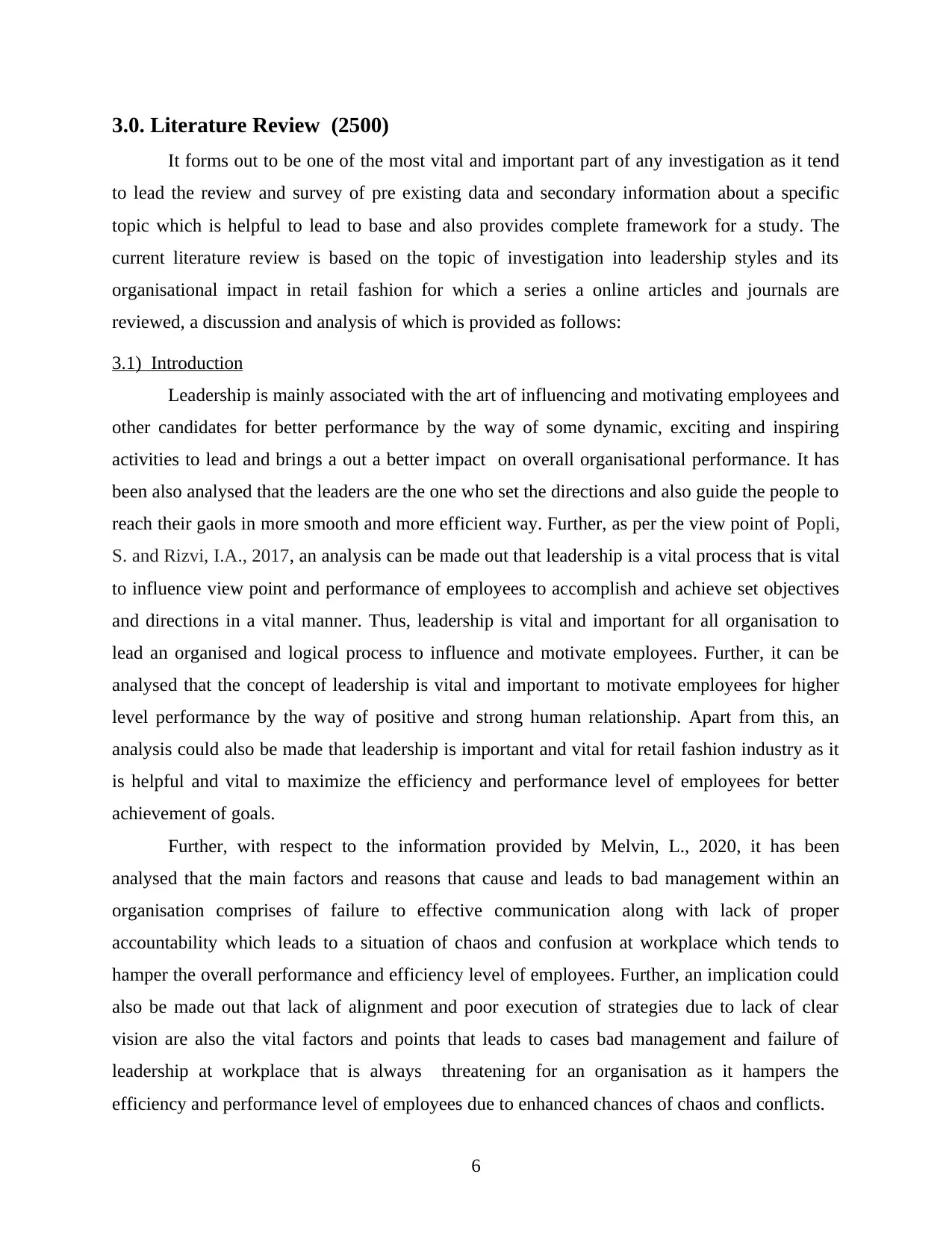
3.0. Literature Review (2500)
It forms out to be one of the most vital and important part of any investigation as it tend
to lead the review and survey of pre existing data and secondary information about a specific
topic which is helpful to lead to base and also provides complete framework for a study. The
current literature review is based on the topic of investigation into leadership styles and its
organisational impact in retail fashion for which a series a online articles and journals are
reviewed, a discussion and analysis of which is provided as follows:
3.1) Introduction
Leadership is mainly associated with the art of influencing and motivating employees and
other candidates for better performance by the way of some dynamic, exciting and inspiring
activities to lead and brings a out a better impact on overall organisational performance. It has
been also analysed that the leaders are the one who set the directions and also guide the people to
reach their gaols in more smooth and more efficient way. Further, as per the view point of Popli,
S. and Rizvi, I.A., 2017, an analysis can be made out that leadership is a vital process that is vital
to influence view point and performance of employees to accomplish and achieve set objectives
and directions in a vital manner. Thus, leadership is vital and important for all organisation to
lead an organised and logical process to influence and motivate employees. Further, it can be
analysed that the concept of leadership is vital and important to motivate employees for higher
level performance by the way of positive and strong human relationship. Apart from this, an
analysis could also be made that leadership is important and vital for retail fashion industry as it
is helpful and vital to maximize the efficiency and performance level of employees for better
achievement of goals.
Further, with respect to the information provided by Melvin, L., 2020, it has been
analysed that the main factors and reasons that cause and leads to bad management within an
organisation comprises of failure to effective communication along with lack of proper
accountability which leads to a situation of chaos and confusion at workplace which tends to
hamper the overall performance and efficiency level of employees. Further, an implication could
also be made out that lack of alignment and poor execution of strategies due to lack of clear
vision are also the vital factors and points that leads to cases bad management and failure of
leadership at workplace that is always threatening for an organisation as it hampers the
efficiency and performance level of employees due to enhanced chances of chaos and conflicts.
6
It forms out to be one of the most vital and important part of any investigation as it tend
to lead the review and survey of pre existing data and secondary information about a specific
topic which is helpful to lead to base and also provides complete framework for a study. The
current literature review is based on the topic of investigation into leadership styles and its
organisational impact in retail fashion for which a series a online articles and journals are
reviewed, a discussion and analysis of which is provided as follows:
3.1) Introduction
Leadership is mainly associated with the art of influencing and motivating employees and
other candidates for better performance by the way of some dynamic, exciting and inspiring
activities to lead and brings a out a better impact on overall organisational performance. It has
been also analysed that the leaders are the one who set the directions and also guide the people to
reach their gaols in more smooth and more efficient way. Further, as per the view point of Popli,
S. and Rizvi, I.A., 2017, an analysis can be made out that leadership is a vital process that is vital
to influence view point and performance of employees to accomplish and achieve set objectives
and directions in a vital manner. Thus, leadership is vital and important for all organisation to
lead an organised and logical process to influence and motivate employees. Further, it can be
analysed that the concept of leadership is vital and important to motivate employees for higher
level performance by the way of positive and strong human relationship. Apart from this, an
analysis could also be made that leadership is important and vital for retail fashion industry as it
is helpful and vital to maximize the efficiency and performance level of employees for better
achievement of goals.
Further, with respect to the information provided by Melvin, L., 2020, it has been
analysed that the main factors and reasons that cause and leads to bad management within an
organisation comprises of failure to effective communication along with lack of proper
accountability which leads to a situation of chaos and confusion at workplace which tends to
hamper the overall performance and efficiency level of employees. Further, an implication could
also be made out that lack of alignment and poor execution of strategies due to lack of clear
vision are also the vital factors and points that leads to cases bad management and failure of
leadership at workplace that is always threatening for an organisation as it hampers the
efficiency and performance level of employees due to enhanced chances of chaos and conflicts.
6
⊘ This is a preview!⊘
Do you want full access?
Subscribe today to unlock all pages.

Trusted by 1+ million students worldwide
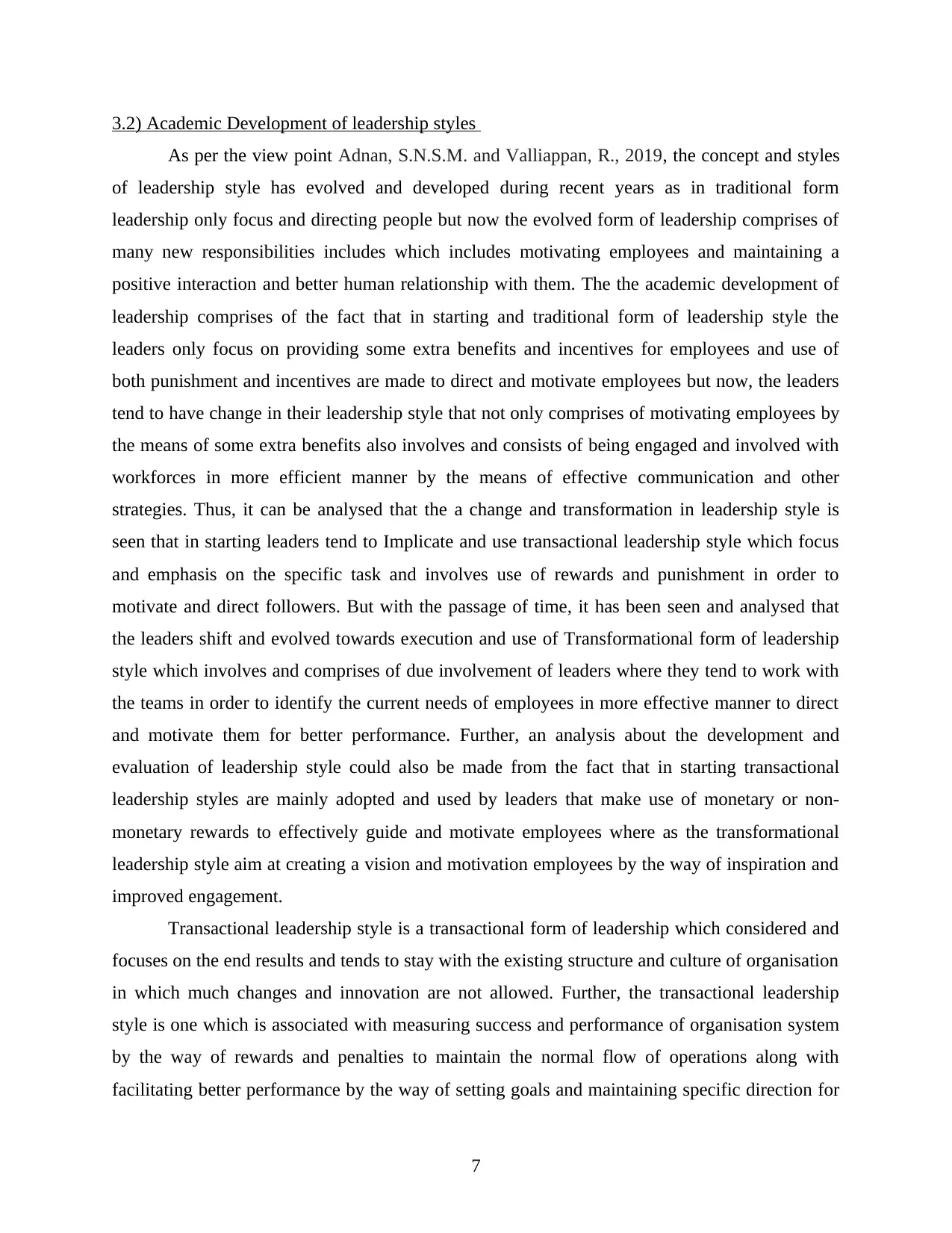
3.2) Academic Development of leadership styles
As per the view point Adnan, S.N.S.M. and Valliappan, R., 2019, the concept and styles
of leadership style has evolved and developed during recent years as in traditional form
leadership only focus and directing people but now the evolved form of leadership comprises of
many new responsibilities includes which includes motivating employees and maintaining a
positive interaction and better human relationship with them. The the academic development of
leadership comprises of the fact that in starting and traditional form of leadership style the
leaders only focus on providing some extra benefits and incentives for employees and use of
both punishment and incentives are made to direct and motivate employees but now, the leaders
tend to have change in their leadership style that not only comprises of motivating employees by
the means of some extra benefits also involves and consists of being engaged and involved with
workforces in more efficient manner by the means of effective communication and other
strategies. Thus, it can be analysed that the a change and transformation in leadership style is
seen that in starting leaders tend to Implicate and use transactional leadership style which focus
and emphasis on the specific task and involves use of rewards and punishment in order to
motivate and direct followers. But with the passage of time, it has been seen and analysed that
the leaders shift and evolved towards execution and use of Transformational form of leadership
style which involves and comprises of due involvement of leaders where they tend to work with
the teams in order to identify the current needs of employees in more effective manner to direct
and motivate them for better performance. Further, an analysis about the development and
evaluation of leadership style could also be made from the fact that in starting transactional
leadership styles are mainly adopted and used by leaders that make use of monetary or non-
monetary rewards to effectively guide and motivate employees where as the transformational
leadership style aim at creating a vision and motivation employees by the way of inspiration and
improved engagement.
Transactional leadership style is a transactional form of leadership which considered and
focuses on the end results and tends to stay with the existing structure and culture of organisation
in which much changes and innovation are not allowed. Further, the transactional leadership
style is one which is associated with measuring success and performance of organisation system
by the way of rewards and penalties to maintain the normal flow of operations along with
facilitating better performance by the way of setting goals and maintaining specific direction for
7
As per the view point Adnan, S.N.S.M. and Valliappan, R., 2019, the concept and styles
of leadership style has evolved and developed during recent years as in traditional form
leadership only focus and directing people but now the evolved form of leadership comprises of
many new responsibilities includes which includes motivating employees and maintaining a
positive interaction and better human relationship with them. The the academic development of
leadership comprises of the fact that in starting and traditional form of leadership style the
leaders only focus on providing some extra benefits and incentives for employees and use of
both punishment and incentives are made to direct and motivate employees but now, the leaders
tend to have change in their leadership style that not only comprises of motivating employees by
the means of some extra benefits also involves and consists of being engaged and involved with
workforces in more efficient manner by the means of effective communication and other
strategies. Thus, it can be analysed that the a change and transformation in leadership style is
seen that in starting leaders tend to Implicate and use transactional leadership style which focus
and emphasis on the specific task and involves use of rewards and punishment in order to
motivate and direct followers. But with the passage of time, it has been seen and analysed that
the leaders shift and evolved towards execution and use of Transformational form of leadership
style which involves and comprises of due involvement of leaders where they tend to work with
the teams in order to identify the current needs of employees in more effective manner to direct
and motivate them for better performance. Further, an analysis about the development and
evaluation of leadership style could also be made from the fact that in starting transactional
leadership styles are mainly adopted and used by leaders that make use of monetary or non-
monetary rewards to effectively guide and motivate employees where as the transformational
leadership style aim at creating a vision and motivation employees by the way of inspiration and
improved engagement.
Transactional leadership style is a transactional form of leadership which considered and
focuses on the end results and tends to stay with the existing structure and culture of organisation
in which much changes and innovation are not allowed. Further, the transactional leadership
style is one which is associated with measuring success and performance of organisation system
by the way of rewards and penalties to maintain the normal flow of operations along with
facilitating better performance by the way of setting goals and maintaining specific direction for
7
Paraphrase This Document
Need a fresh take? Get an instant paraphrase of this document with our AI Paraphraser
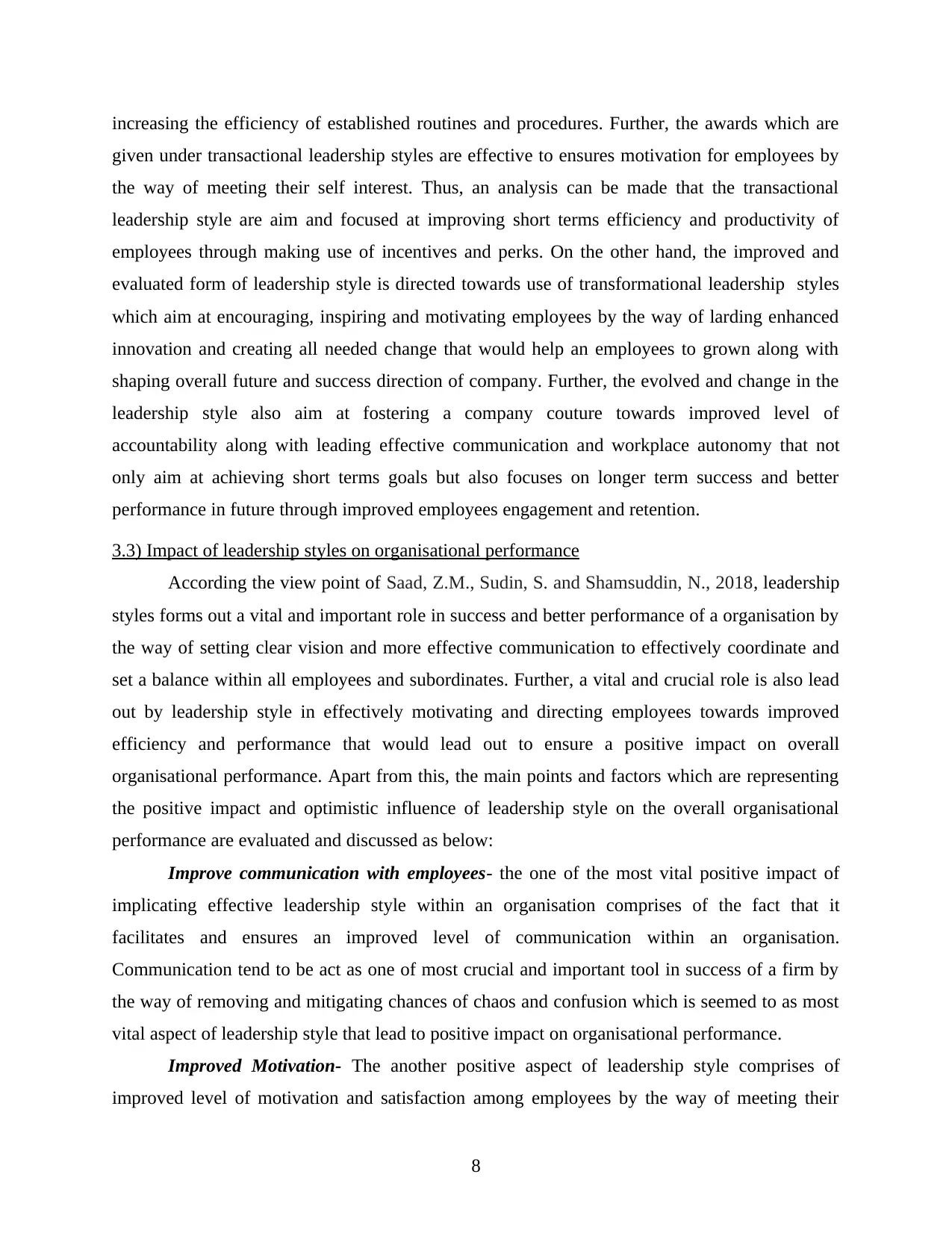
increasing the efficiency of established routines and procedures. Further, the awards which are
given under transactional leadership styles are effective to ensures motivation for employees by
the way of meeting their self interest. Thus, an analysis can be made that the transactional
leadership style are aim and focused at improving short terms efficiency and productivity of
employees through making use of incentives and perks. On the other hand, the improved and
evaluated form of leadership style is directed towards use of transformational leadership styles
which aim at encouraging, inspiring and motivating employees by the way of larding enhanced
innovation and creating all needed change that would help an employees to grown along with
shaping overall future and success direction of company. Further, the evolved and change in the
leadership style also aim at fostering a company couture towards improved level of
accountability along with leading effective communication and workplace autonomy that not
only aim at achieving short terms goals but also focuses on longer term success and better
performance in future through improved employees engagement and retention.
3.3) Impact of leadership styles on organisational performance
According the view point of Saad, Z.M., Sudin, S. and Shamsuddin, N., 2018, leadership
styles forms out a vital and important role in success and better performance of a organisation by
the way of setting clear vision and more effective communication to effectively coordinate and
set a balance within all employees and subordinates. Further, a vital and crucial role is also lead
out by leadership style in effectively motivating and directing employees towards improved
efficiency and performance that would lead out to ensure a positive impact on overall
organisational performance. Apart from this, the main points and factors which are representing
the positive impact and optimistic influence of leadership style on the overall organisational
performance are evaluated and discussed as below:
Improve communication with employees- the one of the most vital positive impact of
implicating effective leadership style within an organisation comprises of the fact that it
facilitates and ensures an improved level of communication within an organisation.
Communication tend to be act as one of most crucial and important tool in success of a firm by
the way of removing and mitigating chances of chaos and confusion which is seemed to as most
vital aspect of leadership style that lead to positive impact on organisational performance.
Improved Motivation- The another positive aspect of leadership style comprises of
improved level of motivation and satisfaction among employees by the way of meeting their
8
given under transactional leadership styles are effective to ensures motivation for employees by
the way of meeting their self interest. Thus, an analysis can be made that the transactional
leadership style are aim and focused at improving short terms efficiency and productivity of
employees through making use of incentives and perks. On the other hand, the improved and
evaluated form of leadership style is directed towards use of transformational leadership styles
which aim at encouraging, inspiring and motivating employees by the way of larding enhanced
innovation and creating all needed change that would help an employees to grown along with
shaping overall future and success direction of company. Further, the evolved and change in the
leadership style also aim at fostering a company couture towards improved level of
accountability along with leading effective communication and workplace autonomy that not
only aim at achieving short terms goals but also focuses on longer term success and better
performance in future through improved employees engagement and retention.
3.3) Impact of leadership styles on organisational performance
According the view point of Saad, Z.M., Sudin, S. and Shamsuddin, N., 2018, leadership
styles forms out a vital and important role in success and better performance of a organisation by
the way of setting clear vision and more effective communication to effectively coordinate and
set a balance within all employees and subordinates. Further, a vital and crucial role is also lead
out by leadership style in effectively motivating and directing employees towards improved
efficiency and performance that would lead out to ensure a positive impact on overall
organisational performance. Apart from this, the main points and factors which are representing
the positive impact and optimistic influence of leadership style on the overall organisational
performance are evaluated and discussed as below:
Improve communication with employees- the one of the most vital positive impact of
implicating effective leadership style within an organisation comprises of the fact that it
facilitates and ensures an improved level of communication within an organisation.
Communication tend to be act as one of most crucial and important tool in success of a firm by
the way of removing and mitigating chances of chaos and confusion which is seemed to as most
vital aspect of leadership style that lead to positive impact on organisational performance.
Improved Motivation- The another positive aspect of leadership style comprises of
improved level of motivation and satisfaction among employees by the way of meeting their
8
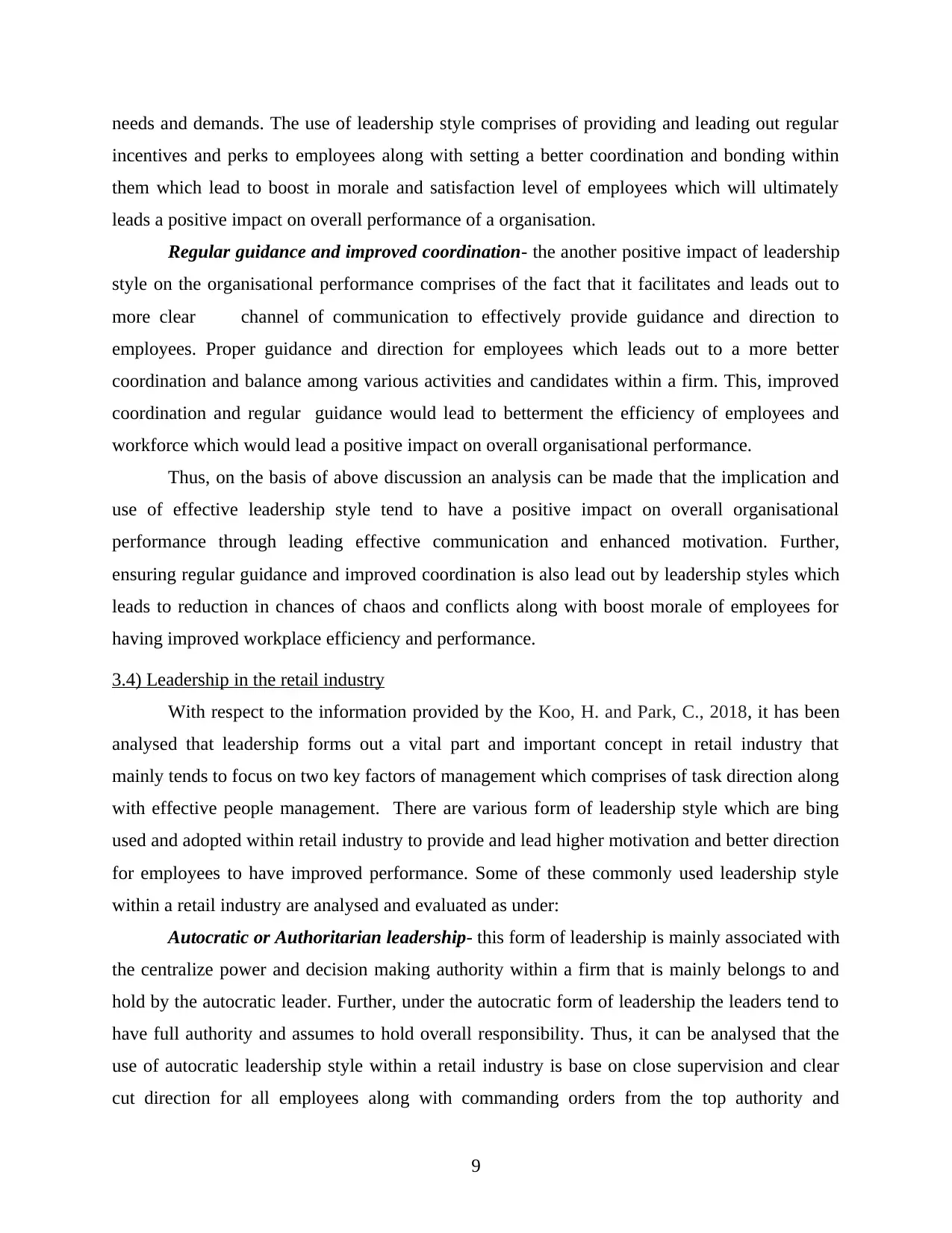
needs and demands. The use of leadership style comprises of providing and leading out regular
incentives and perks to employees along with setting a better coordination and bonding within
them which lead to boost in morale and satisfaction level of employees which will ultimately
leads a positive impact on overall performance of a organisation.
Regular guidance and improved coordination- the another positive impact of leadership
style on the organisational performance comprises of the fact that it facilitates and leads out to
more clear channel of communication to effectively provide guidance and direction to
employees. Proper guidance and direction for employees which leads out to a more better
coordination and balance among various activities and candidates within a firm. This, improved
coordination and regular guidance would lead to betterment the efficiency of employees and
workforce which would lead a positive impact on overall organisational performance.
Thus, on the basis of above discussion an analysis can be made that the implication and
use of effective leadership style tend to have a positive impact on overall organisational
performance through leading effective communication and enhanced motivation. Further,
ensuring regular guidance and improved coordination is also lead out by leadership styles which
leads to reduction in chances of chaos and conflicts along with boost morale of employees for
having improved workplace efficiency and performance.
3.4) Leadership in the retail industry
With respect to the information provided by the Koo, H. and Park, C., 2018, it has been
analysed that leadership forms out a vital part and important concept in retail industry that
mainly tends to focus on two key factors of management which comprises of task direction along
with effective people management. There are various form of leadership style which are bing
used and adopted within retail industry to provide and lead higher motivation and better direction
for employees to have improved performance. Some of these commonly used leadership style
within a retail industry are analysed and evaluated as under:
Autocratic or Authoritarian leadership- this form of leadership is mainly associated with
the centralize power and decision making authority within a firm that is mainly belongs to and
hold by the autocratic leader. Further, under the autocratic form of leadership the leaders tend to
have full authority and assumes to hold overall responsibility. Thus, it can be analysed that the
use of autocratic leadership style within a retail industry is base on close supervision and clear
cut direction for all employees along with commanding orders from the top authority and
9
incentives and perks to employees along with setting a better coordination and bonding within
them which lead to boost in morale and satisfaction level of employees which will ultimately
leads a positive impact on overall performance of a organisation.
Regular guidance and improved coordination- the another positive impact of leadership
style on the organisational performance comprises of the fact that it facilitates and leads out to
more clear channel of communication to effectively provide guidance and direction to
employees. Proper guidance and direction for employees which leads out to a more better
coordination and balance among various activities and candidates within a firm. This, improved
coordination and regular guidance would lead to betterment the efficiency of employees and
workforce which would lead a positive impact on overall organisational performance.
Thus, on the basis of above discussion an analysis can be made that the implication and
use of effective leadership style tend to have a positive impact on overall organisational
performance through leading effective communication and enhanced motivation. Further,
ensuring regular guidance and improved coordination is also lead out by leadership styles which
leads to reduction in chances of chaos and conflicts along with boost morale of employees for
having improved workplace efficiency and performance.
3.4) Leadership in the retail industry
With respect to the information provided by the Koo, H. and Park, C., 2018, it has been
analysed that leadership forms out a vital part and important concept in retail industry that
mainly tends to focus on two key factors of management which comprises of task direction along
with effective people management. There are various form of leadership style which are bing
used and adopted within retail industry to provide and lead higher motivation and better direction
for employees to have improved performance. Some of these commonly used leadership style
within a retail industry are analysed and evaluated as under:
Autocratic or Authoritarian leadership- this form of leadership is mainly associated with
the centralize power and decision making authority within a firm that is mainly belongs to and
hold by the autocratic leader. Further, under the autocratic form of leadership the leaders tend to
have full authority and assumes to hold overall responsibility. Thus, it can be analysed that the
use of autocratic leadership style within a retail industry is base on close supervision and clear
cut direction for all employees along with commanding orders from the top authority and
9
⊘ This is a preview!⊘
Do you want full access?
Subscribe today to unlock all pages.

Trusted by 1+ million students worldwide
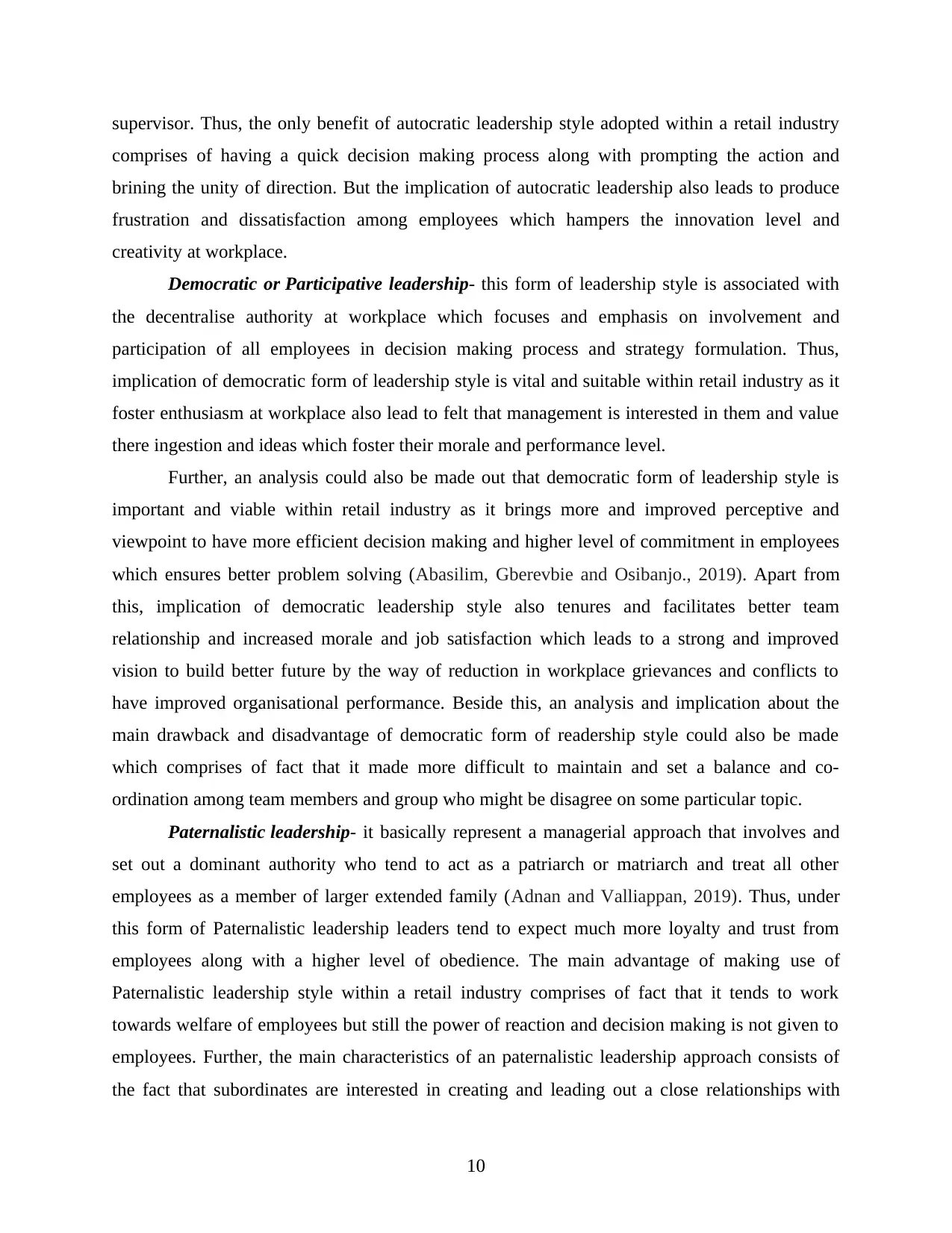
supervisor. Thus, the only benefit of autocratic leadership style adopted within a retail industry
comprises of having a quick decision making process along with prompting the action and
brining the unity of direction. But the implication of autocratic leadership also leads to produce
frustration and dissatisfaction among employees which hampers the innovation level and
creativity at workplace.
Democratic or Participative leadership- this form of leadership style is associated with
the decentralise authority at workplace which focuses and emphasis on involvement and
participation of all employees in decision making process and strategy formulation. Thus,
implication of democratic form of leadership style is vital and suitable within retail industry as it
foster enthusiasm at workplace also lead to felt that management is interested in them and value
there ingestion and ideas which foster their morale and performance level.
Further, an analysis could also be made out that democratic form of leadership style is
important and viable within retail industry as it brings more and improved perceptive and
viewpoint to have more efficient decision making and higher level of commitment in employees
which ensures better problem solving (Abasilim, Gberevbie and Osibanjo., 2019). Apart from
this, implication of democratic leadership style also tenures and facilitates better team
relationship and increased morale and job satisfaction which leads to a strong and improved
vision to build better future by the way of reduction in workplace grievances and conflicts to
have improved organisational performance. Beside this, an analysis and implication about the
main drawback and disadvantage of democratic form of readership style could also be made
which comprises of fact that it made more difficult to maintain and set a balance and co-
ordination among team members and group who might be disagree on some particular topic.
Paternalistic leadership- it basically represent a managerial approach that involves and
set out a dominant authority who tend to act as a patriarch or matriarch and treat all other
employees as a member of larger extended family (Adnan and Valliappan, 2019). Thus, under
this form of Paternalistic leadership leaders tend to expect much more loyalty and trust from
employees along with a higher level of obedience. The main advantage of making use of
Paternalistic leadership style within a retail industry comprises of fact that it tends to work
towards welfare of employees but still the power of reaction and decision making is not given to
employees. Further, the main characteristics of an paternalistic leadership approach consists of
the fact that subordinates are interested in creating and leading out a close relationships with
10
comprises of having a quick decision making process along with prompting the action and
brining the unity of direction. But the implication of autocratic leadership also leads to produce
frustration and dissatisfaction among employees which hampers the innovation level and
creativity at workplace.
Democratic or Participative leadership- this form of leadership style is associated with
the decentralise authority at workplace which focuses and emphasis on involvement and
participation of all employees in decision making process and strategy formulation. Thus,
implication of democratic form of leadership style is vital and suitable within retail industry as it
foster enthusiasm at workplace also lead to felt that management is interested in them and value
there ingestion and ideas which foster their morale and performance level.
Further, an analysis could also be made out that democratic form of leadership style is
important and viable within retail industry as it brings more and improved perceptive and
viewpoint to have more efficient decision making and higher level of commitment in employees
which ensures better problem solving (Abasilim, Gberevbie and Osibanjo., 2019). Apart from
this, implication of democratic leadership style also tenures and facilitates better team
relationship and increased morale and job satisfaction which leads to a strong and improved
vision to build better future by the way of reduction in workplace grievances and conflicts to
have improved organisational performance. Beside this, an analysis and implication about the
main drawback and disadvantage of democratic form of readership style could also be made
which comprises of fact that it made more difficult to maintain and set a balance and co-
ordination among team members and group who might be disagree on some particular topic.
Paternalistic leadership- it basically represent a managerial approach that involves and
set out a dominant authority who tend to act as a patriarch or matriarch and treat all other
employees as a member of larger extended family (Adnan and Valliappan, 2019). Thus, under
this form of Paternalistic leadership leaders tend to expect much more loyalty and trust from
employees along with a higher level of obedience. The main advantage of making use of
Paternalistic leadership style within a retail industry comprises of fact that it tends to work
towards welfare of employees but still the power of reaction and decision making is not given to
employees. Further, the main characteristics of an paternalistic leadership approach consists of
the fact that subordinates are interested in creating and leading out a close relationships with
10
Paraphrase This Document
Need a fresh take? Get an instant paraphrase of this document with our AI Paraphraser
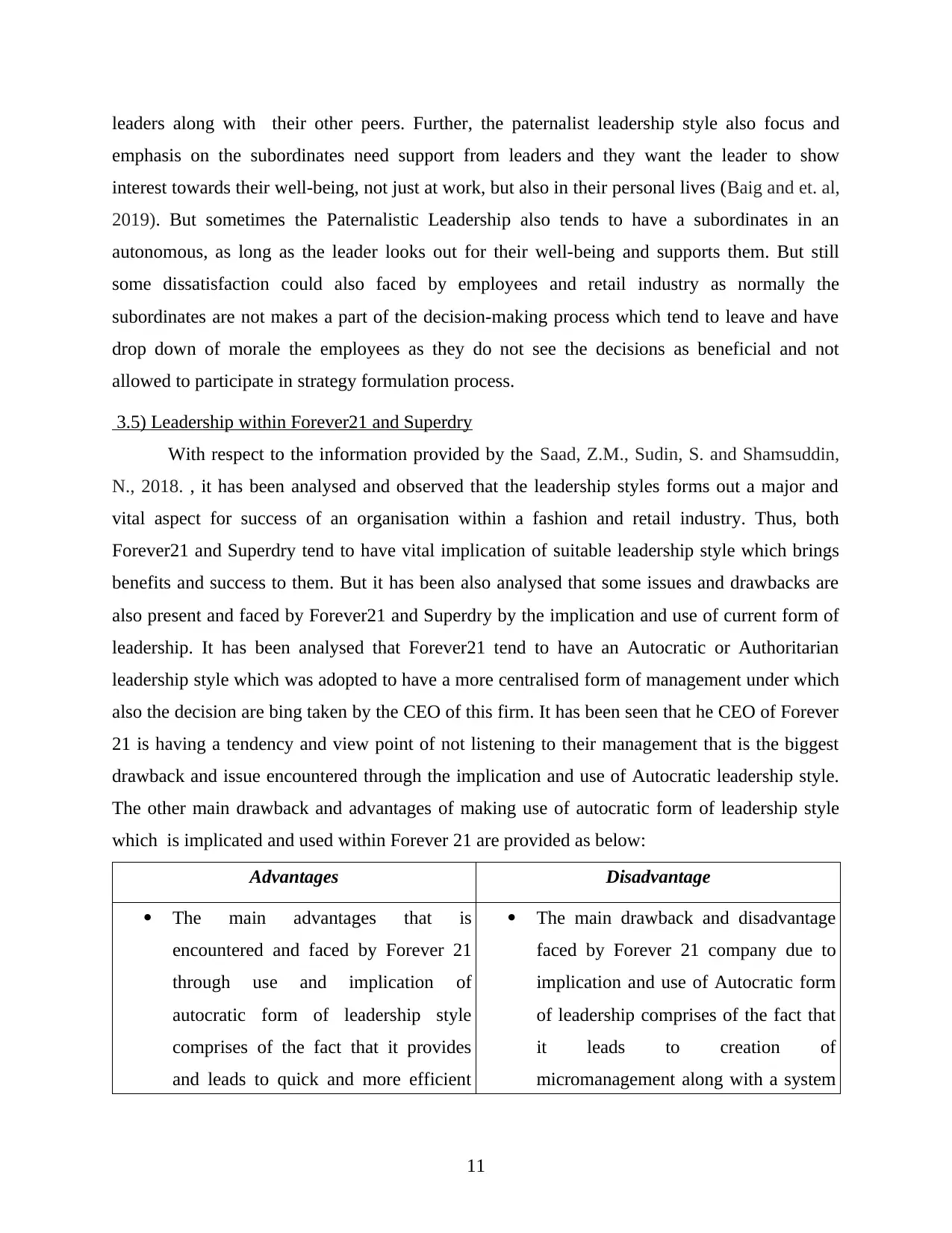
leaders along with their other peers. Further, the paternalist leadership style also focus and
emphasis on the subordinates need support from leaders and they want the leader to show
interest towards their well-being, not just at work, but also in their personal lives (Baig and et. al,
2019). But sometimes the Paternalistic Leadership also tends to have a subordinates in an
autonomous, as long as the leader looks out for their well-being and supports them. But still
some dissatisfaction could also faced by employees and retail industry as normally the
subordinates are not makes a part of the decision-making process which tend to leave and have
drop down of morale the employees as they do not see the decisions as beneficial and not
allowed to participate in strategy formulation process.
3.5) Leadership within Forever21 and Superdry
With respect to the information provided by the Saad, Z.M., Sudin, S. and Shamsuddin,
N., 2018. , it has been analysed and observed that the leadership styles forms out a major and
vital aspect for success of an organisation within a fashion and retail industry. Thus, both
Forever21 and Superdry tend to have vital implication of suitable leadership style which brings
benefits and success to them. But it has been also analysed that some issues and drawbacks are
also present and faced by Forever21 and Superdry by the implication and use of current form of
leadership. It has been analysed that Forever21 tend to have an Autocratic or Authoritarian
leadership style which was adopted to have a more centralised form of management under which
also the decision are bing taken by the CEO of this firm. It has been seen that he CEO of Forever
21 is having a tendency and view point of not listening to their management that is the biggest
drawback and issue encountered through the implication and use of Autocratic leadership style.
The other main drawback and advantages of making use of autocratic form of leadership style
which is implicated and used within Forever 21 are provided as below:
Advantages Disadvantage
The main advantages that is
encountered and faced by Forever 21
through use and implication of
autocratic form of leadership style
comprises of the fact that it provides
and leads to quick and more efficient
The main drawback and disadvantage
faced by Forever 21 company due to
implication and use of Autocratic form
of leadership comprises of the fact that
it leads to creation of
micromanagement along with a system
11
emphasis on the subordinates need support from leaders and they want the leader to show
interest towards their well-being, not just at work, but also in their personal lives (Baig and et. al,
2019). But sometimes the Paternalistic Leadership also tends to have a subordinates in an
autonomous, as long as the leader looks out for their well-being and supports them. But still
some dissatisfaction could also faced by employees and retail industry as normally the
subordinates are not makes a part of the decision-making process which tend to leave and have
drop down of morale the employees as they do not see the decisions as beneficial and not
allowed to participate in strategy formulation process.
3.5) Leadership within Forever21 and Superdry
With respect to the information provided by the Saad, Z.M., Sudin, S. and Shamsuddin,
N., 2018. , it has been analysed and observed that the leadership styles forms out a major and
vital aspect for success of an organisation within a fashion and retail industry. Thus, both
Forever21 and Superdry tend to have vital implication of suitable leadership style which brings
benefits and success to them. But it has been also analysed that some issues and drawbacks are
also present and faced by Forever21 and Superdry by the implication and use of current form of
leadership. It has been analysed that Forever21 tend to have an Autocratic or Authoritarian
leadership style which was adopted to have a more centralised form of management under which
also the decision are bing taken by the CEO of this firm. It has been seen that he CEO of Forever
21 is having a tendency and view point of not listening to their management that is the biggest
drawback and issue encountered through the implication and use of Autocratic leadership style.
The other main drawback and advantages of making use of autocratic form of leadership style
which is implicated and used within Forever 21 are provided as below:
Advantages Disadvantage
The main advantages that is
encountered and faced by Forever 21
through use and implication of
autocratic form of leadership style
comprises of the fact that it provides
and leads to quick and more efficient
The main drawback and disadvantage
faced by Forever 21 company due to
implication and use of Autocratic form
of leadership comprises of the fact that
it leads to creation of
micromanagement along with a system
11
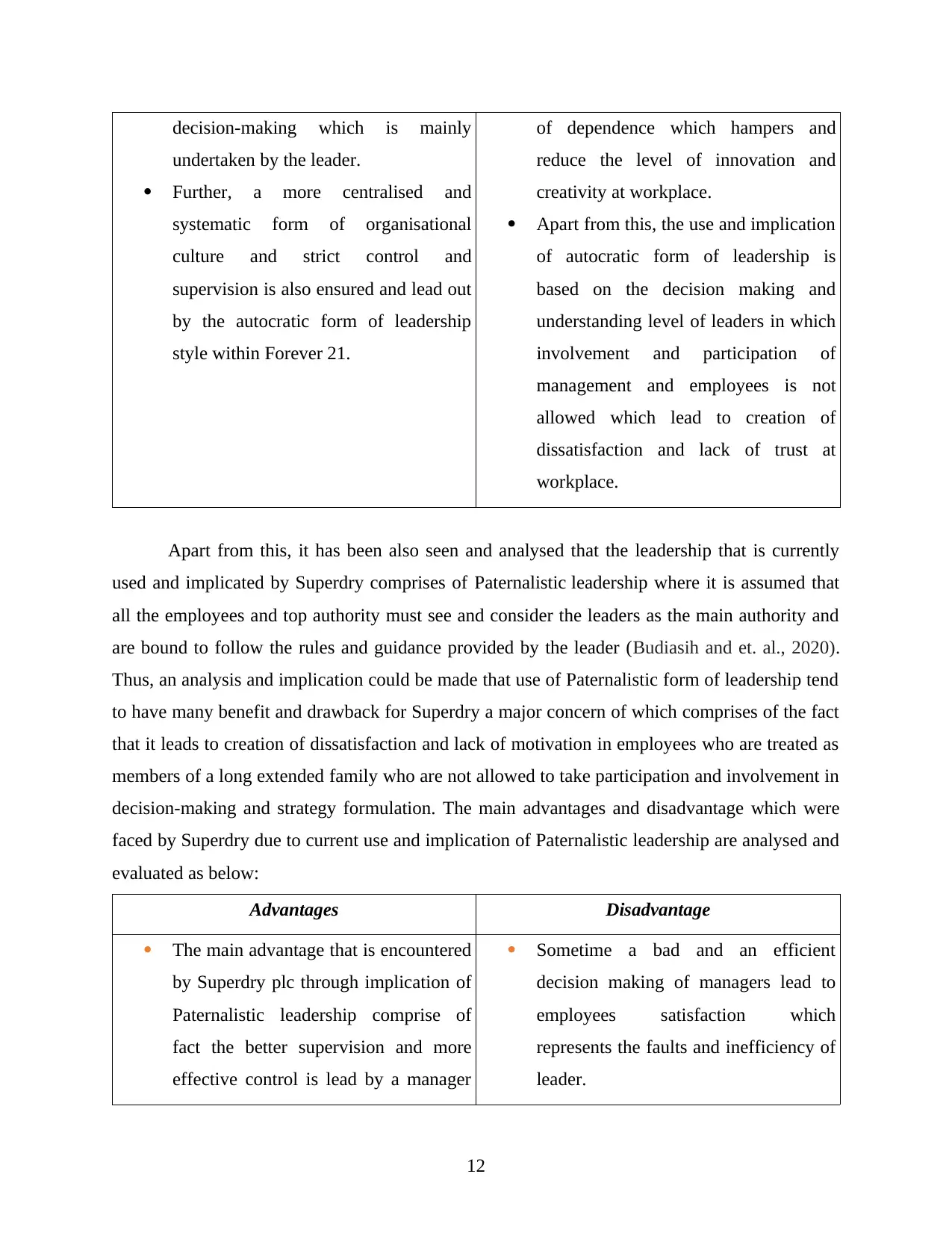
decision-making which is mainly
undertaken by the leader.
Further, a more centralised and
systematic form of organisational
culture and strict control and
supervision is also ensured and lead out
by the autocratic form of leadership
style within Forever 21.
of dependence which hampers and
reduce the level of innovation and
creativity at workplace.
Apart from this, the use and implication
of autocratic form of leadership is
based on the decision making and
understanding level of leaders in which
involvement and participation of
management and employees is not
allowed which lead to creation of
dissatisfaction and lack of trust at
workplace.
Apart from this, it has been also seen and analysed that the leadership that is currently
used and implicated by Superdry comprises of Paternalistic leadership where it is assumed that
all the employees and top authority must see and consider the leaders as the main authority and
are bound to follow the rules and guidance provided by the leader (Budiasih and et. al., 2020).
Thus, an analysis and implication could be made that use of Paternalistic form of leadership tend
to have many benefit and drawback for Superdry a major concern of which comprises of the fact
that it leads to creation of dissatisfaction and lack of motivation in employees who are treated as
members of a long extended family who are not allowed to take participation and involvement in
decision-making and strategy formulation. The main advantages and disadvantage which were
faced by Superdry due to current use and implication of Paternalistic leadership are analysed and
evaluated as below:
Advantages Disadvantage
The main advantage that is encountered
by Superdry plc through implication of
Paternalistic leadership comprise of
fact the better supervision and more
effective control is lead by a manager
Sometime a bad and an efficient
decision making of managers lead to
employees satisfaction which
represents the faults and inefficiency of
leader.
12
undertaken by the leader.
Further, a more centralised and
systematic form of organisational
culture and strict control and
supervision is also ensured and lead out
by the autocratic form of leadership
style within Forever 21.
of dependence which hampers and
reduce the level of innovation and
creativity at workplace.
Apart from this, the use and implication
of autocratic form of leadership is
based on the decision making and
understanding level of leaders in which
involvement and participation of
management and employees is not
allowed which lead to creation of
dissatisfaction and lack of trust at
workplace.
Apart from this, it has been also seen and analysed that the leadership that is currently
used and implicated by Superdry comprises of Paternalistic leadership where it is assumed that
all the employees and top authority must see and consider the leaders as the main authority and
are bound to follow the rules and guidance provided by the leader (Budiasih and et. al., 2020).
Thus, an analysis and implication could be made that use of Paternalistic form of leadership tend
to have many benefit and drawback for Superdry a major concern of which comprises of the fact
that it leads to creation of dissatisfaction and lack of motivation in employees who are treated as
members of a long extended family who are not allowed to take participation and involvement in
decision-making and strategy formulation. The main advantages and disadvantage which were
faced by Superdry due to current use and implication of Paternalistic leadership are analysed and
evaluated as below:
Advantages Disadvantage
The main advantage that is encountered
by Superdry plc through implication of
Paternalistic leadership comprise of
fact the better supervision and more
effective control is lead by a manager
Sometime a bad and an efficient
decision making of managers lead to
employees satisfaction which
represents the faults and inefficiency of
leader.
12
⊘ This is a preview!⊘
Do you want full access?
Subscribe today to unlock all pages.

Trusted by 1+ million students worldwide
1 out of 24
Related Documents
Your All-in-One AI-Powered Toolkit for Academic Success.
+13062052269
info@desklib.com
Available 24*7 on WhatsApp / Email
![[object Object]](/_next/static/media/star-bottom.7253800d.svg)
Unlock your academic potential
Copyright © 2020–2025 A2Z Services. All Rights Reserved. Developed and managed by ZUCOL.





